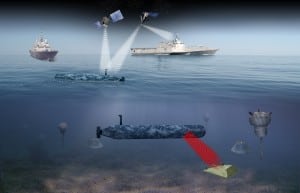
The Knifefish unmanned underwater vehicle designed for hunting mines as part of the mine countermeasures mission module for the Navy’s Littoral Combat Ships is scheduled for a first round of sea testing this summer. General Dynamics [GD], which is developing the Knifefish for the Navy, has been building the first UUV and testing the sensors for detecting mines. It has been working through technical issues in moving from prototyping phase to production, said Tom Mason, the senior program manager for…













